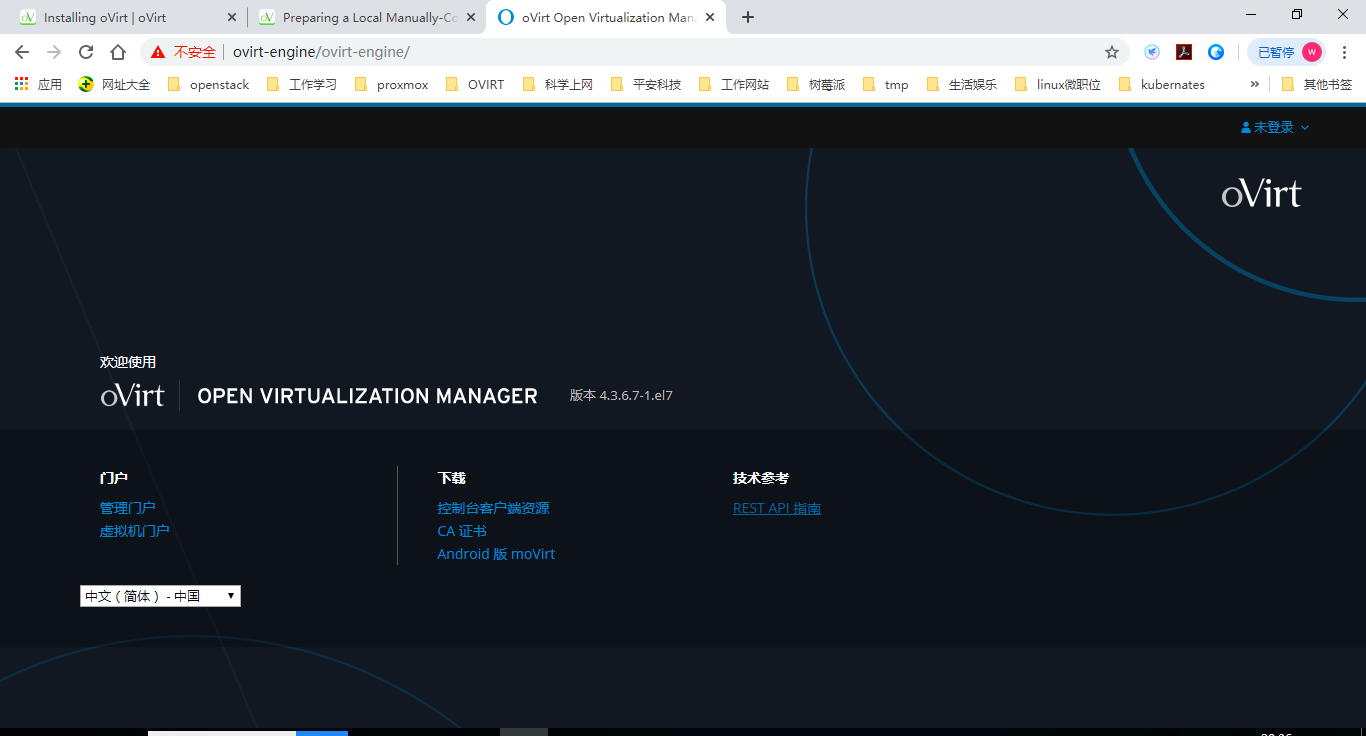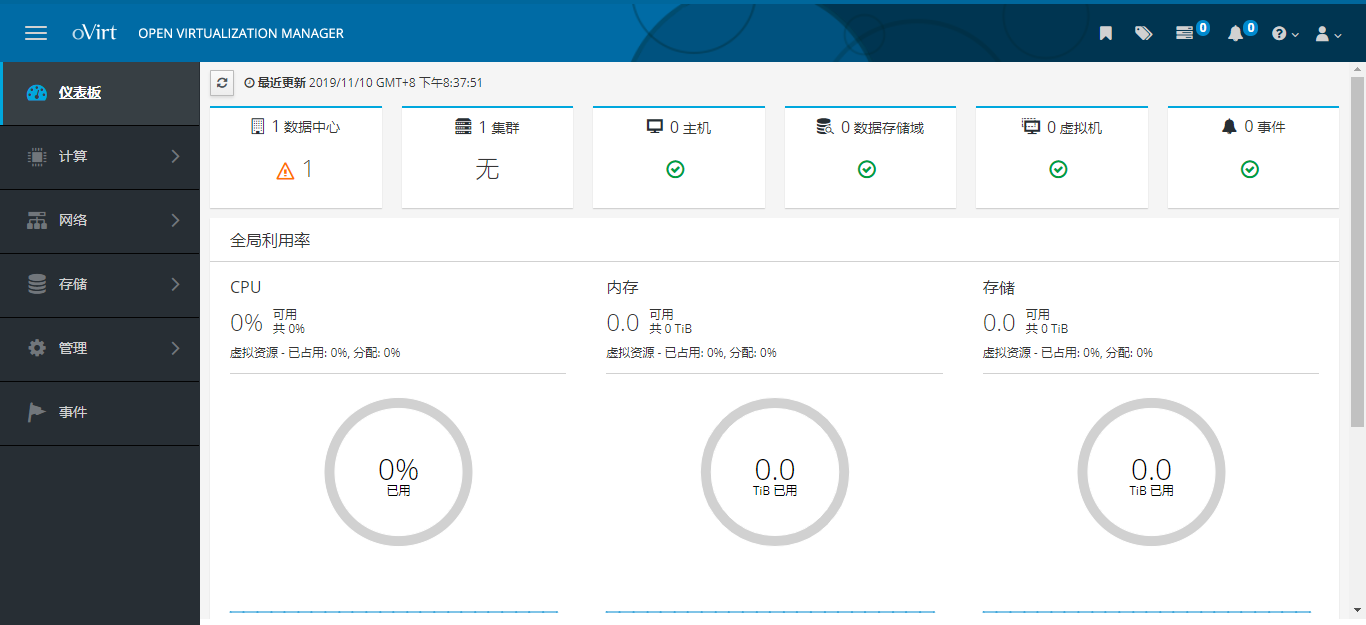In the process of studying the desktop cloud, it is found that there is not much difference between the server (private cloud or virtualization) and the application of thin client and the management of the desktop. The final landing may require customized development to meet the needs.
In the open source virtualization products, limited to their own experience and vision, Ovirt has never been contacted before. In the process of communication with friends, it is found that Ovirt is more grounded for desktop cloud solutions and has the advantage of project implementation.
Here's a record of the familiarization process of installing oVirt test environment for the first time.
Ovirt official website installation reference:
https://ovirt.org/documentation/install-guide/Installation_Guide.html
Preparation before installation:
Download CentOS 7.8 and ovirt node installation images:
CentOS-7-x86_64-DVD-1908
ovirt-node-ng-installer-4.3.6-2019092614.el7
Ovirt engine official website installation document:
https://ovirt.org/documentation/install-guide/chap-Installing_oVirt.html
Create two virtual machines to install CentOS 7.8, one to install the ovirt engine, and one to install the host in your own PVE test environment.
Edit the / etc/hosts file:
192.168.170.110 ovirt-manager.yuweibing.com ovirt-engine
192.168.170.114 ovirt-host1.yuweibing.com ovirt-host1
Configure IP address (omitted)
Modify host name (omitted)
Install step by step according to the above ovirt engine official website installation document, where, execute the following command:
# yum install ovirt-engine
It took a long time to download the package. The network speed was very slow, about 10k-20k or even lower. The 400M package took several hours to download.
After that, you need to configure ovirt engine
Not familiar with postgresql database, please refer to the online novice tutorial:
http://www.ruanyifeng.com/blog/2013/12/getting_started_with_postgresql.html
More detailed tutorial:
https://www.runoob.com/postgresql/postgresql-tutorial.html
Perform configuration initialization:
[root@ovirt-engine ~]# engine-setup [ INFO ] Stage: Initializing [ INFO ] Stage: Environment setup Configuration files: ['/etc/ovirt-engine-setup.conf.d/10-packaging-jboss.conf', '/etc/ovirt-engine-setup.conf.d/10-packaging.conf'] Log file: /var/log/ovirt-engine/setup/ovirt-engine-setup-20191110071238-dhorop.log Version: otopi-1.8.3 (otopi-1.8.3-1.el7) [ INFO ] Stage: Environment packages setup [ INFO ] Stage: Programs detection [ INFO ] Stage: Environment setup (late) [ INFO ] Stage: Environment customization --== PRODUCT OPTIONS ==-- Set up Cinderlib integration (Currently in tech preview) (Yes, No) [No]: Configure Engine on this host (Yes, No) [Yes]: Configure ovirt-provider-ovn (Yes, No) [Yes]: Configure WebSocket Proxy on this host (Yes, No) [Yes]: * Please note * : Data Warehouse is required for the engine. If you choose to not configure it on this host, you have to configure it on a remote host, and then configure the engine on this host so that it can access the database of the remote Data Warehouse host. Configure Data Warehouse on this host (Yes, No) [Yes]: Configure Image I/O Proxy on this host (Yes, No) [Yes]: Configure VM Console Proxy on this host (Yes, No) [Yes]: --== PACKAGES ==-- [ INFO ] Checking for product updates... [ INFO ] No product updates found --== NETWORK CONFIGURATION ==-- Host fully qualified DNS name of this server [ovirt-engine]: [WARNING] Host name ovirt-engine has no domain suffix [WARNING] Failed to resolve ovirt-engine using DNS, it can be resolved only locally Setup can automatically configure the firewall on this system. Note: automatic configuration of the firewall may overwrite current settings. NOTICE: iptables is deprecated and will be removed in future releases Do you want Setup to configure the firewall? (Yes, No) [Yes]: [ INFO ] firewalld will be configured as firewall manager. [WARNING] Host name ovirt-engine has no domain suffix [WARNING] Host name ovirt-engine has no domain suffix [WARNING] Host name ovirt-engine has no domain suffix --== DATABASE CONFIGURATION ==-- Where is the DWH database located? (Local, Remote) [Local]: Setup can configure the local postgresql server automatically for the DWH to run. This may conflict with existing applications. Would you like Setup to automatically configure postgresql and create DWH database, or prefer to perform that manually? (Automatic, Manual) [Automatic]: Where is the Engine database located? (Local, Remote) [Local]: Setup can configure the local postgresql server automatically for the engine to run. This may conflict with existing applications. Would you like Setup to automatically configure postgresql and create Engine database, or prefer to perform that manually? (Automatic, Manual) [Automatic]: --== OVIRT ENGINE CONFIGURATION ==-- Engine admin password: Confirm engine admin password: [WARNING] Password is weak: The password is shorter than 8 characters Use weak password? (Yes, No) [No]: yes Application mode (Virt, Gluster, Both) [Both]: Use default credentials (admin@internal) for ovirt-provider-ovn (Yes, No) [Yes]: --== STORAGE CONFIGURATION ==-- Default SAN wipe after delete (Yes, No) [No]: --== PKI CONFIGURATION ==-- Organization name for certificate [Test]: --== APACHE CONFIGURATION ==-- Setup can configure the default page of the web server to present the application home page. This may conflict with existing applications. Do you wish to set the application as the default page of the web server? (Yes, No) [Yes]: Setup can configure apache to use SSL using a certificate issued from the internal CA. Do you wish Setup to configure that, or prefer to perform that manually? (Automatic, Manual) [Automatic]: --== SYSTEM CONFIGURATION ==-- --== MISC CONFIGURATION ==-- Please choose Data Warehouse sampling scale: (1) Basic (2) Full (1, 2)[1]: --== END OF CONFIGURATION ==-- [ INFO ] Stage: Setup validation [WARNING] Less than 16384MB of memory is available --== CONFIGURATION PREVIEW ==-- Application mode : both Default SAN wipe after delete : False Firewall manager : firewalld Update Firewall : True Host FQDN : ovirt-engine Set up Cinderlib integration : False Configure local Engine database : True Set application as default page : True Configure Apache SSL : True Engine database secured connection : False Engine database user name : engine Engine database name : engine Engine database host : localhost Engine database port : 5432 Engine database host name validation : False Engine installation : True PKI organization : Test Set up ovirt-provider-ovn : True Configure WebSocket Proxy : True DWH installation : True DWH database host : localhost DWH database port : 5432 Configure local DWH database : True Configure Image I/O Proxy : True Configure VMConsole Proxy : True Please confirm installation settings (OK, Cancel) [OK]: [ INFO ] Stage: Transaction setup [ INFO ] Stopping engine service [ INFO ] Stopping ovirt-fence-kdump-listener service [ INFO ] Stopping dwh service [ INFO ] Stopping Image I/O Proxy service [ INFO ] Stopping vmconsole-proxy service [ INFO ] Stopping websocket-proxy service [ INFO ] Stage: Misc configuration (early) [ INFO ] Stage: Package installation [ INFO ] Stage: Misc configuration [ INFO ] Upgrading CA [ INFO ] Creating PostgreSQL 'engine' database [ INFO ] Configuring PostgreSQL [ INFO ] Creating PostgreSQL 'ovirt_engine_history' database [ INFO ] Configuring PostgreSQL [ INFO ] Creating CA [ INFO ] Creating/refreshing DWH database schema [ INFO ] Configuring Image I/O Proxy [ INFO ] Setting up ovirt-vmconsole proxy helper PKI artifacts [ INFO ] Setting up ovirt-vmconsole SSH PKI artifacts [ INFO ] Configuring WebSocket Proxy [ INFO ] Creating/refreshing Engine database schema [ INFO ] Creating/refreshing Engine 'internal' domain database schema [ INFO ] Creating default mac pool range [ INFO ] Adding default OVN provider to database [ INFO ] Adding OVN provider secret to database [ INFO ] Setting a password for internal user admin [ INFO ] Generating post install configuration file '/etc/ovirt-engine-setup.conf.d/20-setup-ovirt-post.conf' [ INFO ] Stage: Transaction commit [ INFO ] Stage: Closing up [ INFO ] Starting engine service [ INFO ] Starting dwh service [ INFO ] Restarting ovirt-vmconsole proxy service --== SUMMARY ==-- [ INFO ] Restarting httpd Please use the user 'admin@internal' and password specified in order to login Web access is enabled at: http://ovirt-engine:80/ovirt-engine https://ovirt-engine:443/ovirt-engine Internal CA 9D:C4:BF:DF:0B:8C:CF:A4:1E:91:E9:DE:86:E3:58:5E:B6:E9:22:A1 SSH fingerprint: SHA256:H6Uuo1NeCIU9+Me4uIb55hDtA9pUtRBOozB+tobKBEo [WARNING] Less than 16384MB of memory is available --== END OF SUMMARY ==-- [ INFO ] Stage: Clean up Log file is located at /var/log/ovirt-engine/setup/ovirt-engine-setup-20191110071238-dhorop.log [ INFO ] Generating answer file '/var/lib/ovirt-engine/setup/answers/20191110071842-setup.conf' [ INFO ] Stage: Pre-termination [ INFO ] Stage: Termination [ INFO ] Execution of setup completed successfully [root@ovirt-engine ~]#
Installation succeeded. You need to use the domain name to access the web management page:
Edit the c:\windows\system32\drivers\etc\hosts file of this computer, and add:
192.168.170.110 ovirt-manager.yuweibing.com ovirt-engine
192.168.170.114 ovirt-host1.yuweibing.com ovirt-host1
Then visit the website:
http://ovirt-engine:80/ovirt-engine

Account password: admin/engine
